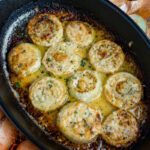The humble onion is as indispensable to the culinary arts as butter or eggs—or for that matter, knives or plates.
It’s the rare food that can be sweet, savory, pungent and aromatic all at the same time, but that’s what onions do. In a real sense, onions are what make food food—going beyond mere sustenance and making it enjoyable. Making it taste good.
Onions don’t contribute much in the way of nutrition. A few vitamins and minerals, sure, but nothing that isn’t far more abundant in other commonly available foods like rice or broccoli. Nor are onions functionally necessary for any recipe. If you took them away, everything would still work, it just wouldn’t taste as good.
Onions can be roasted, grilled, pickled, caramelized, battered and deep-fried, sliced thinly or chopped and served raw in salads, sandwiches, dips, or as a garnish for tacos, making them among the most versatile ingredients in the culinary arts.
Onions are part of the genus Allium, and they’re related to garlic, chives, shallots, and leeks. Both the bulb and the shoots are edible. Slicing onions release a sulfur-based vapor that irritates the eyes.
China produces the most onions of any country on earth, but they have 1.3 billion people to feed, so they use most of what they grow. Interestingly, the world’s top onion exporter happens to be the Netherlands.
Yellow Onions
The workhorse, the staple, the everyday brown beauty, yellow onions are suitable for any conceivable use. You could easily live a rich and fulfilling life even if this were the only onion you ever tasted.
Its heavy brown parchment skin surrounds ivory white flesh with a strong, sulphury, pungent flavor and aroma. If a recipe says onion without specifying what type, it’s assumed to be a yellow onion. Use them for making French onion soup.
Sweet Onions
Larger and slightly flatter than yellow onions, with lighter colored, less opaque skin, sweet onions contain extra sugar, making them good for caramelizing. Their larger size and sweeter flavor make them ideal for making onion rings. Sweet onion varieties include Walla Walla, Maui, Vidalia, as well as others with the word “sweet” in the name.
White Onions
White onions have a papery white skin, and their flavor is milder and sweeter than yellow onions, making them good for serving raw in fresh salsa or homemade guacamole.
Red Onions
Sweet and mild enough to be eaten raw, both the exterior skin and the flesh of red onions are a deep magenta color, which makes them particularly good additions to salads or anywhere else a splash of color will enhance the appearance of the dish. Use red onions in salads and on sandwiches and burgers.
Shallots
Shallots are small, brown-skinned onions with purplish flesh, and their bulbs are made up of multiple lobes, a little bit like the way garlic bulbs are divided into individual cloves. Pungent and garlicky, shallots are possibly the most sublime onion.
They impart a very intense flavor, and because they’re smaller, composed of thinner layers, they can be minced very finely and used in salad dressings and sauces. They’re lovely to roast, however; peel and halve them, and toss them in the bottom of the pan when you’re roasting a chicken.
Green Onions
Green onions are immature onions that have not yet formed a bulb, or only partially. The entire plant is usually used, including the tall green shoots, and they make a wonderful garnish for soups, omelets, tacos, as well as color and crunch. They go by other names, including scallions, spring onions and salad onions.
Leeks
Leeks are a truly marvelous vegetable, and also sadly underappreciated. Shaped like overgrown scallions, leeks are lovely in soups and sauces. Baking the leeks mellows their flavor and softens them.
Sweet Onion Casserole with Crispy Topping
Ingredients
- 2.5 lbs sweet onions
- ½ cup butter
- ½ tsp salt
- ¾ cup water can substitute sherry for half of the water
- 2 tsp sugar
- 2 tsp balsamic vinegar
- 1 cup panko breadcrumbs
- 1 tbsp olive oil
- 1 tsp chives chopped
- 1 tsp parsley chopped
Instructions
- Preheat oven to 350°
- Peel and thinly slice the onions.
- Heat butter in a skillet, add the onions and salt. Stir to coat onions in butter.
- Cook uncovered over low heat for 30 minutes until the onions are soft but not coloured.
- Turn up the heat and add water (and sherry if using), sugar, and balsamic vinegar. Let the mixture bubble gently for 10 to 15 minutes until the liquid has evaporated and the onions are meltingly tender.
- Transfer the onions to a casserole dish.
- Heat the olive oil in a non stick skillet and add in the breadcrumbs. Cook over medium heat until the start to brown.
- Remove from heat and sprinkle over the hot onions. Bake for 10 minutes, sprinkle with herbs and serve immediately.
Asiago Roasted Onions
Ingredients
- 4 large yellow onions peeled and sliced into ½" slices
- ½ tsp thyme chopped
- salt & pepper to taste
- 1 cup heavy cream
- 2 tsp dijon mustard
- ½ cup Asiago cheese grated
Instructions
- Place the slices of onion in a single layer on the bottom of a greased baking dish, drizzle with oil and season with thyme, salt and pepper before roasting in a preheated 450° oven for 20 minutes.
- Meanwhile, heat the heavy cream in a small saucepan until it starts to simmer, mix in the mustard and half of the cheese, let the cheese melt pour it over the onions before sprinkling on the remaining cheese.
- Cover in foil and bake for 20 minutes. (The onions will be tender, the cheese melted and the sides bubbling when it is done.)


